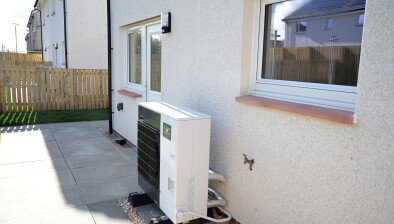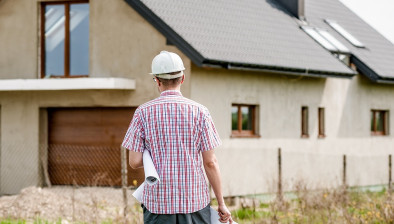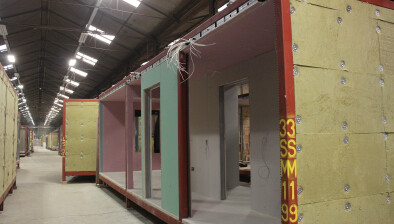Government to consult over Scottish equivalent of Passivhaus standard

Alex Rowley MSP kicked off work at one of Scotland’s first social housing developments to be built to Passivhaus standards in 2021
An agreed definition of a Scottish equivalent of the Passivhaus standard which will become the minimum for all new housing in the country is to be the subject of consultation between the Scottish Government and the building industry, Patrick Harvie has confirmed.
Last month, the Scottish Government agreed to progress legislation proposed by Scottish Labour MSP Alex Rowley that will see all new-build homes in Scotland having a new minimum standard of energy efficiency to ensure they are warmer, greener and cheaper to run.
Mr Rowley’s Proposed Domestic Building Environmental Standards (Scotland) Bill was to “introduce new minimum environmental design standards for all new-build housing to meet the Passivhaus standard, or a Scottish equivalent, in order to improve energy efficiency and thermal performance”.
The Scottish Government agreed to progress the substance of the Bill via secondary legislation, rather than the more time consuming parliamentary legislative route. This means that the new regulations will be able to be passed and scrutinised by a committee of the Scottish Parliament rather than the Parliament as a whole.
In a statement to Holyrood this week, Mr Harvie, the minister for zero carbon buildings, active travel and tenants’ rights, announced it intends to go down the ‘Scottish equivalent’ route and that the new standards would be delivered via this subordinate legislation.
He said: “This is not just about reducing carbon emissions, critical though addressing the climate emergency is; it is also essential if we are to meet the cost of living challenge and remove the vulnerability that people are exposed to through high and volatile fossil fuel prices.”
Responding to the announcement, Carolyn Lochhead, director of external affairs at the Scottish Federation of Housing Associations (SFHA), argued that any Scottish equivalent of the Passivhaus standard must be coupled with significant financial support.
“While we share the Scottish Government’s strong desire to tackle fuel poverty and the climate emergency, if strict mandated standards are to be introduced, they must be coupled with significant support to ensure this is deliverable and affordable for our members and their tenants,” Carolyn said.
She added: “The social housing sector is already at the forefront of vital work to reduce carbon emissions from buildings and tackle fuel poverty – and we take that responsibility seriously. However, we must also continue to be clear about the potential real-world impact. The increased costs to build these homes, maintain them and the limited supply chain capacity to deliver at scale pose a potential risk to achieving our shared ambition to deliver 110,000 more affordable homes by 2032. This is set within the context of already challenging times for development and cuts to the Affordable Housing Supply Programme budget.
“We support the ambition of designing new homes with the lowest energy demand as possible and the Passivhaus standard has already been adopted in a number of social housing projects. However, further consideration of how a ‘Scottish equivalent’ could be designed, implemented and paid for will be critical.
“In the coming months, we’ll be engaging with the Scottish Government to ensure our members’ voices are heard and that we reach the very best outcome for social landlords and tenants.”
Ashley Campbell, policy and practice manager at CIH Scotland, warned that the costs of implementing the standard must be fairly shared.
She saud: “We welcome the drive to improve building standards – everyone should have access to a good quality home that is warm and affordable. The commitment to developing a ‘Scottish equivalent’ to Passivhaus should help to avoid an overly restrictive scheme which would be reliant on certification from a handful of registered assessors. In our view, this approach would not have been workable.
“In developing the new standard, the Scottish Government must work closely with the housing sector and developers to ensure that any additional costs are manageable and do not lead to a reduction in much needed housing supply. It is estimated that Passivhaus standard adds between £8,000 - £16,000 to a new home. Even the lower end of this estimate would add £880 million to the Scottish Government’s 110,000 affordable housing supply programme and this simply cannot be absorbed by social landlords.
“At the same time, we must not lose focus on improving our existing housing stock. Around one million homes across all tenures will require significant investment if we are to meet net zero. For social landlords, this means finding resources from already stretched budgets if further funding is not provided. Private landlords and homeowners also need clear guidance and support from the Scottish Government to navigate what can be a complex maze of information, products and services.
“We agree that swift action is needed to meet net zero but the costs of doing so need to be shared in a fair way.”
David Bookbinder, director at Glasgow and West of Scotland Forum of Housing Associations, highlighted that the vast majority of carbon savings will come from improving existing homes.
He said: “In technical terms, achieving high energy efficiency standards is easier in new build than in existing stock, and so it’s right that we should be ambitious for our new build programme.
“That said, legislating is usually the easy bit. Scotland is some way from having the regulatory and supply chain capacity and expertise in Passivhaus technology, and so it may make sense for us to adopt a standard with sufficient flexibility to embrace a variety of approaches which can achieve the same or similar outcome to Passivhaus without being tied to an unduly rigid standard.
“On funding, the additional cost of meeting higher standards will need to be met through grant. GWSF doesn’t accept that higher rents can be charged on the basis that fuel bills will be lower, as this argument is based on the premise that tenants could afford high fuel bills in the first place. New build costs are already very high, compared with just 2-3 years ago, and there’s evidence of reluctance to fund such costs in some areas, so we need to be cautious about adding still further to the cost of a new home.
“And whilst it’s usually new build which sets the example on standards, we need to remember that by far the greatest carbon savings will come from improving existing stock - and especially privately owned housing. We still find ourselves some way from the introduction of mandatory energy efficiency standards for private housing, with no government really relishing the prospect of telling owners how to manage their homes.”
Housebuilders claim new design standards will hamper meeting the country’s housing needs.
Homes for Scotland has said the country has a 100,000 shortfall of new homes accumulated since 2007 and that the government should have prioritised retrofitting existing ones.
Public affairs director Jennifer Kennedy said: “New homes are only a small proportion of the overall housing stock and are already highly-energy efficient with further improvements to come through building standards.”
She added: “If politicians are serious about tackling fuel poverty and the climate emergency, the focus must be on retrofitting the bulk of existing properties that are predominantly responsible for residential emissions.”
Passivhaus standards include eliminating thermal bridging, using superior windows, mechanical ventilation and heat recovery, plus high-quality insulation and airtight construction.
More details of the standards will be published by the Scottish Government in Spring 2023 and in place within two years of December 2022.
Passivhaus chief executive Jon Bootlalnd said: “The Scottish Parliament is to be applauded for taking this crucial step towards meeting their net-zero climate emergency goals. Now we must ensure the bill is well developed and implemented to deliver the greatest impact on the actual performance of new homes in Scotland.”


















